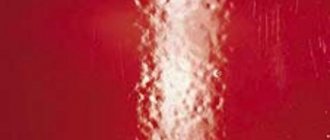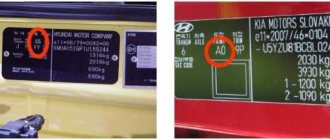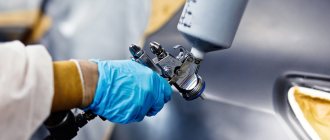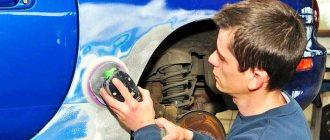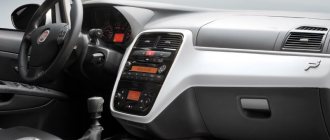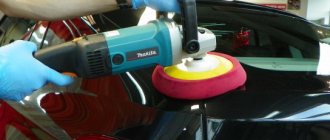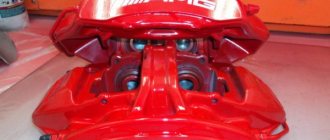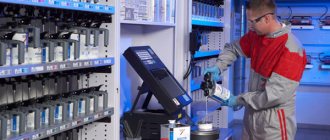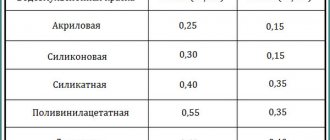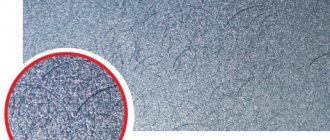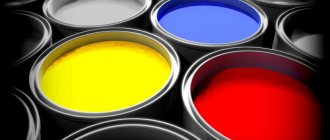Modern hammer paint has practically nothing to do with the instrument of the same name, except that the texture of the product that is painted with it is a bit like the head of a hammer.
High-quality hammer paint is used to paint car parts, in particular the body. This differs from other coatings in that it is characterized by a certain severity of perception and a certain coldness. In addition, we can note the ideal resistance to adverse environmental influences. All this contributes to the growing popularity of this coating.
Preparatory work
ATTENTION! A completely simple way to reduce fuel consumption has been found! Don't believe me? An auto mechanic with 15 years of experience also didn’t believe it until he tried it. And now he saves 35,000 rubles a year on gasoline! Read more"
The process of preparing the surface of a vehicle, as well as all its components, for painting with hammer paint is practically no different from preparing for the application of other paints. The only thing that needs to be taken into account is that the final sanding of the soil should be done with sandpaper, the grit of which corresponds to the P800 grade.
If you use paper of a smaller grain size, the preparation process can have the opposite effect, since the complete absence of any roughness significantly impairs the adhesion of the coating to the surface itself, and also does not result in a relief attractive structure, characteristic specifically for the process of painting with hammer paint. The main thing is to know how to paint with hammer paint correctly.
Main features of coating application
The most common technology for high-quality painting of products with the described hammer paint is similar to the process of applying paints of other brands, with the exception of some differences. The painting process is carried out using the most common tools that are usually used when working with other paints.
You will need materials and equipment such as:
- Spray gun;
- Brush;
- Roller made on a velor base;
- Directly the paint itself;
- Solvent 647;
- Primer-enamel;
- High quality abrasive paper.
A roller and a brush are necessary for the reason that it will be much more convenient to paint some elements of the car with just such tools in order to obtain the desired result. A roller and brush will help to achieve some relief in the coating. Also, their use will provide a slight metallic sheen with an attractive drizzle effect.
You need to pay attention to the nozzle hole. Hammer paint is known for its increased viscosity, so its diameter should be slightly larger than for regular paint.
It is not always possible to achieve the optimal result in the process of painting with hammer paints by using a spray gun. It is for this reason that in certain cases some parts need to be painted with a roller or brush. This does not mean at all that this method requires painting the entire body, but some elements that are painted with a brush will look quite attractive.
The algorithm for painting a car with hammer paint is as follows:
- Initially, the surface of the car is degreased and cleaned. If you give it a certain roughness, then a more effective adhesion of the paint will be ensured.
- If there are rust spots on the car, they need to be treated with a special rust converter. For minor flaws, this step can be skipped. Most modern hammer paints contain components that effectively cover all areas of corrosion and, moreover, prevent them from spreading. The use of this enamel will help reduce the time for complete rust removal.
- Only after cleaning and treating the surface can hammer paint be applied to it. You should not dilute it with other solutions to avoid violating the required proportion of all ingredients.
- Paint is applied using a special roller. It is recommended to use a brush only in exceptional cases, as it consumes a lot of paint. The surface of the vehicle must be matte, since this enamel does not adhere to a glossy finish. Here you can use a special sandpaper to treat the entire surface of the car.
- After applying the first coat of paint with a roller, you need to wait 30 minutes before applying another coat. Then the process of painting the car with a pooler is carried out. Strictly 4 layers are applied, between which it is important to maintain 20-minute breaks. The application of high-quality hammer enamel must be carried out strictly at a certain temperature, which should be no lower than 10 and no higher than 30 degrees.
- To give the car the most textured pattern, you will need multi-layer paint, but in this case it is important not to overdo it and not exceed the required thickness.
- The paint dries completely within 6 hours, and the temperature should be at room temperature. The car can be put into operation only after 2 or 3 days.
How to profitably exchange a used car
To guarantee the legality of the used car exchange service and its objective cost, the purchase and sale process should be carried out at a trusted auto center. Here the client will be offered:
- Diagnostics of the old model, on the basis of which its cost will be determined;
- Selection of cars for exchange, completely new or with a clean mileage history: all cars undergo forensic examination, therefore the car dealership will never sell a car with a “dark past”;
- Legal support of the transaction: the client enters into a notarized agreement and, if necessary, can use the credit services of the car dealership’s partner bank;
- Efficiency of the service: the client does not need to look for buyers for his vehicle; he does not need to settle issues with the traffic police or the bank. The listed functions are the task of the auto center.
Read here! Where is the body number
Thus, with minimal documents, it is possible to buy an improved car within one to three days. The used car exchange service makes it possible to regularly change the owner’s vehicle fleet by purchasing its best models.
Important Tips
High-quality painting is possible not only in a specialized workshop, but also in an ordinary garage. If you correctly follow certain technologies and properly organize the work process, you can quite effectively paint your car with hammer paint.
Many modern car owners have small compressors at their disposal. Such equipment can be adapted to carry out high-quality painting work. It is enough to simply equip it with a special additional receiver, the volume of which is approximately 200 liters. The device will make the dyeing process more stable, and with a relatively small area it will be continuous.
What is hammer paint for metal?
Recently, hammer enamel has become popular in landscape design, interior and exterior decoration. They talk a lot about this product, but they do not specify what hammer paint is, which is why many misconceptions arise. The key difference between the paint is its special texture; it cannot be confused with any other type, since after the surface hardens, it takes on a look similar to numerous blows from a hammer. Because of the specific effect, the substance acquired its name; sometimes it is also called blacksmith’s.
Hammer paint is one of the most durable compounds intended for metal processing.
Hammer effect paint is made from acrylic, alkyd-styrene and epoxy bases. To create a special appearance, aluminum powder, silicone oils and fine glass are added to the composition. Thanks to the presence of special silicone oils in the composition, it is possible to stabilize the texture and provide protection from water.
After mixing all the ingredients, a liquid mixture with the highest adhesion ability is obtained. When the mixture hardens, a high-strength coating appears, which increases the density of the body. Paint is sold in cans and cans.
Types of hammer paint
Hammer enamel, after being applied to a metal surface, forms a coating that is resistant to aggressive environmental influences - temperature changes, mechanical damage, ultraviolet radiation. In addition, enamel with a hammer effect has anti-corrosion properties - the surface painted with it does not oxidize and does not rust even at high air humidity.
The performance properties of this composition are the reason for its widespread use in all areas of industry. In addition to painting cars, hammer enamel for metal is used for painting production equipment, fences and doors, building structures, and electrical appliances.
Types of hammer paint are classified based on the material of the binder base, to which styrene filler and aluminum powder are added (components that give the composition a hammer effect). Alkyd and epoxy resins or cellulose nitrate are used as a binder base.
The following brands of hammer compounds are used for painting cars:
- ML-165 (based on alkyd resins), is used for painting vehicles operated in harsh atmospheric conditions - SUVs, the body of which is constantly in contact with dirt and moisture. ML-165 is classified as heat-resistant paint; it retains its properties when the temperature rises to 125 degrees. This material requires preliminary priming of the surface to be painted; to prepare the working composition, a xylene-based hammer paint solvent is used.
- Rust enamel EP-1323ME (based on epoxy resin) - does not require priming of the surface to be painted (contains a one-component primer). No metal stripping is required; the composition is applied directly to oxidation and scale. The epoxy paint base prevents the further spread of corrosion and has high adhesion to the untreated surface. Polymerization of paint occurs at room temperature, its main disadvantage is the long drying time (up to 48 hours);
- Hammer effect paint NTs-221 (based on cellulose nitrate and colloxylin) is a budget composition that does not have heat resistance and anti-corrosion properties. In fact, this material has only a visual resemblance to similar compositions - when applying it, it requires cleaning the surface from rust and priming.
Choose reliable tools for painting
Along with compositions from domestic manufacturers, Hammerite paint, produced by the English company of the same name, is used. This material is more expensive than its analogues (800-900 rubles per 1 liter), however, due to the addition of silicone filler to the composition, Hamerite has better elasticity and, as a result, resistance to mechanical damage.
Hammerite anti-rust paint does not require prior priming of the surface; it is applied to oxidized metal and prevents the further spread of corrosion. Painting a car with Hammerite hammer paint is carried out in a room with low air humidity, otherwise bubbles will form on the surface, which subsequently crack, which leads to the destruction of the paintwork.
Composition and release form
Hammer enamel for metal, unlike other paints sold in powder form, is sold in finished form. The liquid form was the result of a complex composition and technological preparation features that would be difficult to recreate at home. Paint is sold in tin cans, plastic buckets and spray cans.
Manufacturers are sophisticated by adding various auxiliary components to their compositions, but the standard composition includes:
- aluminum flakes. The inclusion of aluminum creates a characteristic appearance of the coating;
- metal powder. Fine iron adds shine;
- small particles of glass. Aluminum and glass create a special paint texture and increase durability;
Hammer enamel for metal
- silicone and alkyd resins. Added to impart elasticity and improve adhesion;
- wax for technical purposes. Forms a complete protective film.
Manufacturers change the proportions of the listed components and add additional substances; depending on the number of ingredients in the composition, the emphasis is placed on a certain characteristic. There is a dye with a hammer effect and thermal stability.
Methods and features of application to surfaces
Hammerite rust paint is versatile in how it is applied to surfaces. To do this, you can use the following tools available to everyone:
- Paint brushes.
- They are effective when painting structures and products of complex configurations. Hard-to-reach places in such forms abound. Getting to them in order to efficiently apply the Hammerite composition there is the main task. The bottom line is that if the paint does not get to these points, they will serve as sources of formation and development of corrosion centers. This will further lead to its spread over a significant area of the product.
Painting hard-to-reach places - It is better to use brushes made of natural bristles. Make sure that the bristles of the bristles are held well in the metal clamp of the brush. When painting, they should not “come out” of the clamp and remain on the freshly painted surface. If this happens, then the stuck lint should be carefully removed. The area where they were should be re-applied with hammer paint. The brush must be replaced with a new one of better quality.
Painting with a brush - Do not let the brush dry out. If there is a long break in work, wash it thoroughly in solvent and shake off any remaining paint. Store the brush until further use in a jar of clean water to prevent it from drying out. Before next use, shake off the water from the brush and soften the bristles. The best option for long breaks in work is to use a new brush.
- Paint rollers.
- This tool is recommended for use when the task is to paint a large, flat area of metal or other material with Hammerite. Getting the job done quickly is the main advantage of using paint rollers. However, for high-quality painting of the entire product, you still need to use brushes. With their help, those places where it is impossible to reach with a roller are processed.
Painting with a paint roller - Use rollers with a surface made of wool or fur with low pile. If work has been stopped for a long time and the tool has dried out, then its further use is impossible. For the next stage of work, you should use a new roller.
- Make sure that the Hammerite paint is evenly applied to the working surface of the tool. This will ensure the quality of your painting and the productivity of your work. To do this, use special baths into which the painting material is poured. Their size must correspond to the size of the roller. Evenly coated with paint, it will provide a solution to this problem.
- Before use, monitor the viscosity of the paint composition. Hammer paint should not be thick before being applied to the roller. It should be diluted in a ratio of 9:1 (9 parts paint composition and one part Hammerite solvent). After mixing, the composition must be carefully moved to ensure uniformity.
- Pneumatic spray gun (pneumatic spray method).
- It is used for processing large surfaces, including those with medium complexity configurations. This could be, for example, fences or gates made of corrugated sheets, decorative forms of landscape design.
Painting a car using a spray gun - Working with this tool when coating surfaces with Hammerite requires basic skills. You need to be able to use the spray gun in such a way as to ensure uniform coverage of the metal product and prevent drips. The main requirement for achieving a good result in this case is the correct selection of paint viscosity. It should be selected depending on the outside temperature. How to do it? In most cases, it is not possible to measure viscosity due to the fact that most people do not have the appropriate device - a viscometer. Therefore, the assessment is made “by eye”: the higher the ambient temperature, the more diluted the Hammerite composition should be. Accordingly, the paint to solvent ratio of 2:1 recommended when using pneumatic spraying should vary.
- The second point when selecting the viscosity of the composition for the spray gun is the focus on the presence of paint dripping from the surface being painted. This is clearly visible when it is positioned vertically or at an angle. In this situation, the viscosity of Hammerite with a hammer tint when painting metal should be increased. To do this, you can add paint to an already prepared composition or reduce the amount of solvent when preparing a new one.
- Monitor the homogeneity and uniformity of the composition sprayed from the spray gun nozzle. Hammerite paint for high-quality metal coating must be sprayed evenly and have a uniform composition. If it comes out intermittently, you need to clean the nozzle. Do this operation every time after finishing work, and there will be no such problem.
Varieties
There are several main types of paint:
- nitroenamel "NTs-221". This hammer-effect enamel is the cheapest variety, but its role is limited to creating a decorative look. Used when working with interior decoration. It is worth considering that it is subject to corrosion and is afraid of moisture;
- “ML-165” paint is produced with the addition of a styrene and alkyd base. The enamel can withstand high temperatures and tolerates even 130°C. Increased adhesion to most materials has made it popular for interior and exterior applications. The manufacturer allows painting for rust;
- EP-1323 enamel is made from epoxy resin. Used as a dye and primer. Provides thermal protection and prevents corrosion. More often used for processing metal doors, cars, for coating forged products, etc.
- Hammerite paint. The main disadvantage is the high price. The substance is produced in England. During the painting process, the composition also acts as a primer. When the mixture dries, a film is formed to protect the metal elements of the case from oxidation. Based on silicone and alkyd resins. It is not advisable to paint with a spray gun. The main advantage is a wide range of applications, the product can even be applied to rust.
Types of hammer paints
The most popular brands of blacksmith paints:
- ML-165 is an alkyd-styrene-based enamel, characterized by high heat resistance (up to +130°C) and adhesion. Dissolves in xylene. Can be applied to any surface.
- EP-1323 ME – epoxy enamel 2 in 1 (paint and primer), often used for painting truck cranes, cars, forklifts, fences, gates, doors. Apply to rust. Solvents – 648, 667.
- NTs-221 is a “budget” hammer nitro enamel of a more decorative rather than protective nature. It cannot be applied to rust, and in terms of heat resistance it is no better than ordinary enamel. Suitable for indoor and outdoor use.
- Hammerite is an expensive 2 in 1 hammer enamel made in England. The most popular of imported blacksmith's paints. Apply directly to rust.
Hammer paint from the English manufacturer - Hammerite
Note! Regardless of the brand and manufacturer, hammer paint can be sold in cans and spray cans.
Areas of application
The use of hammer paint is possible in most areas:
- for processing various metals. Suitable for coating equipment and metal products made of steel, copper, iron, aluminum, etc.;
- in construction it is used for painting most metal structures;
- application is often carried out on doors, safes and certain types of furniture for industrial use;
- in the automotive industry it is used to cover the body and wheels;
- intended for application to forged products;
- used to create an interesting effect in the interior, the substance gives a feeling of antiquity;
- in advertising it is used for coating glass and plastic.
Painting a car body with hammer paint
Advantages
Use on domestic and industrial appliances and devices often exposed to harsh conditions has demonstrated the extraordinary durability of hammer paint. It withstands temperature changes, vibrations, intense ultraviolet rays, and with its help creates a durable anti-corrosion coating on products made of galvanized materials, steel, and non-ferrous metals. Due to the durability of the coating formed by paint on cast iron and forged products, it has become the object of attention of manufacturers of automotive enamels. The improvements made made the coating good protection against corrosion, which is important for the car body. Areas covered with rust do not need to be pre-treated before applying this paint; the paint reliably “preserves” the damaged area, preventing corrosion from spreading and continuing to damage the metal.
How to use?
When painting a car, buy ready-made enamel with a thick consistency, which, if necessary, is diluted with solvents No. 646-648. Additionally, xylene and solvent can be used, and sometimes gasoline is used. It is better to use a solvent and primer from the same manufacturer; the instructions contain recommendations for dilution.
The technology requires preliminary removal of oil paint from the target area. When painting new metal, be sure to remove the oil coating with a degreaser.
The thicker the applied layer of enamel, the more prominent and larger the design pattern will be.
To avoid an unsightly wave-like pattern on vertical surfaces, it is advisable to apply the paint in a thin layer.
Painting with brush and roller
Before proceeding to staining, it is important to thoroughly mix the enamel so that all heavy particles rise from the bottom and are evenly mixed throughout the liquid. Hammer paint does not necessarily require priming the surface, but with a primer the effect will improve.
The substance hardens quickly, so it should be applied just as quickly in 2-3 layers. There is a pause of about 2 hours between layers, this time will be required for hardening. At first, it is recommended not to drive in rain or fog.
Painting a car using hammer paint
When applying the composition with a roller, follow the same rules as when applying it with a brush. An important condition for a high-quality coating is that a foam roller will not work, as the paint will corrode this material. The best option is to use a fur coat.
Using a spray can and spray gun
When using a spray gun, it is important to know that the process of applying a thick composition of hammer paint requires high pressure - about 6 bar. Before application, you should check the thickness of the enamel; too thick a consistency will lead to clogging of the gun. To properly dilute the substance, it is recommended to use the manufacturer’s instructions located on the paint.
The standard dilution proportion is: 2 parts of the main composition and 1 part of the solvent. Next, cover the surface with enamel in 3 or 4 layers. If processing is carried out in a box, the technology will be slightly different, as will the proportion.
When using an aerosol, paint the surface in 2-3 layers. Before the procedure, shake the can quickly for 10-15 minutes. A distance of 25-30 cm should be maintained from the car to the aerosol.
Modern types of hammer paint
You can buy hammer paint today at any large construction supermarket. Often it comes complete with varnish, and looks much more impressive under it. When applying a layer of hammer paint to the car body, you should get a light shagreen texture.
So, today, among hammer paints for cars, the English “Hammerite” is especially popular. It is the most expensive, but is rightfully considered the best. Its only drawback is the difficulty of applying it on a vertical surface.
There are, however, domestic versions of hammer enamel: it covers well, dries almost on the fly, looks semi-matte and has a “weeping” structure, like frost on glass. The only thing is that in order to achieve a beautiful design, you need to paint with a velor roller - you can’t achieve such “charm” with a gun. Although a good effect can be achieved if you apply three or four layers with a spray gun.
When working with Hammerite paint, it is also important not to forget about personal protective equipment and adhere to the manufacturer’s recommendations, namely: do not paint in the rain when the air is humid (otherwise the paint will come out in pimples that will eventually burst), dilute, as a last resort, only Hammerite Brush Cleaner & Thinners, which, by the way, can also serve as a tool cleaner. You can only use a short-haired roller, but you should spray the aerosol in 4 layers, and not 2-3, like with a brush
Moreover, before use, you need to shake the can for 3 minutes and apply a thin layer from a distance of 20 cm
You can only use a short-haired roller, but you should spray the aerosol in 4 layers, and not 2-3, like with a brush. Moreover, before use, you need to shake the can for 3 minutes and apply a thin layer from a distance of 20 cm.
But the Soviet ones are most often used:
Hammer enamel ML-165 - it is used to paint car bodies and metal products that are exposed to atmospheric conditions. This paint is based on alkyd-styrene enamel. It has good heat resistance and does not change its properties even at a temperature of 130 degrees. The only thing is that before applying it, the surface should be primed and the solvent used is xylene.
Hammer paint EP-1323 ME is an epoxy enamel with a pronounced hammer effect, which contains a primer-enamel composition for rust. It is used to paint not only cars, but even cast iron products. It can be applied directly to clean metal, to scale and to rust. This, of course, does not mean that the surface can generally crumble due to corrosion. The basis of this enamel is epoxy, which forms a resistant and especially durable coating with an anti-corrosion effect. Solvents can be used No. 648 and No. 667.
Hammer enamel NTs-221 from the group of nitro enamels NTs. It is even used indoors. This enamel should be applied to a primed surface by spraying. But this particular enamel practically does not have anti-corrosion properties and the famous heat resistance, but it costs much less than other options. The basis of this paint is a solution of colloxylin with nitrocellulose and aluminum powder. Solvent can be used under number 646.
How to paint a car?
Painting with hammer paint does not cause any particular difficulties when applied to a flat surface, but the entire car has a complex geometric shape. To perform the procedure efficiently, prepare the following tools and materials:
- short nap roller or spray device;
- solvent (No. 646-648);
- primer;
- abrasive.
Solvent for enamels, varnishes and putties B-646
The listed auxiliary materials and tools, as well as the paint itself, are prepared before starting work, as they will be needed at any time. Due to the quick drying of the composition, you will not have time to go get your tools.
Despite the lack of urgent need for priming, professionals still recommend doing it, this will help increase the service life and quality of the coating.
How to paint with hammer paint:
- Dismantle the interfering parts.
- Clean the body from dirt;
- Treat the surface with a solvent to remove oil stains.
- Remove large areas of corrosion with sandpaper. Even in the absence of rot, it is recommended to treat the surface with sandpaper, this will help create roughness for better adhesion to the paint.
- If the corrosion has many spots and they are large-scale, use a rust converter. Hammerite paint is applied with sufficient reliability to areas with corrosion.
- Cover the prepared surface with a primer; it is diluted in advance.
Features of hammer paint
The hammer effect of the paint is achieved by adding fine aluminum powder to the acrylic or epoxy base, which forms a characteristic patterned texture on the painted surface.
This class of paints and varnishes has the following operational advantages:
- Resistance to moisture and precipitation - a silicone filler is added to the composition, which ensures the hydrophobic properties of the painted surface. Expensive materials (Hammerite) contain tiny grains of glass, which further enhance the water-repellent effect;
- Due to the silicone in the composition, the dried paint is elastic, it does not crack or be damaged by mechanical stress, the surface is resistant to scratches and abrasions;
- Hammer enamel for rust is a multicomponent mixture; in addition to the basic components, it includes primer and styrene filler, which prevents further spread of rust oxides on the metal surface;
- Polymerization of compositions based on acrylic and epoxy bases (with the exception of paints based on epoxy resins) occurs in the shortest possible time - up to 30 minutes, at room temperature, which reduces the time of multi-layer painting of a car body;
- After drying, hammer paint for rust forms a protective layer that is not destroyed by splashes of auto chemicals, brake fluid, gasoline and diesel fuel;
- Painting with hammer enamel does not require “jewelry” work to prepare the car body - it is enough to remove pockets of corrosion with sandpaper, level and plaster large deformations.
Sanding a car before painting
You can paint the car body over the old paintwork, giving it a rough surface with sandpaper. Manufacturers claim that you can paint with hammer paint without prior priming, but if you are interested in obtaining a durable and high-quality coating, we recommend covering the surface with 2-3 layers of primer.
The technology of painting with hammer paint does not provide for the possibility of mixing the composition with other types of enamels. Glossy and matte materials should not be mixed with each other. When mixing paint to obtain the required shade, any colors are combined, with the exception of gold and silver.
Is it possible to make blacksmith enamel at home?
The high price of paint led to the search for alternative methods for preparing enamel. Enterprising craftsmen use homemade paint. Using their experience, you can prepare a quite good substance. For the procedure you will need:
- base – UVL-1 varnish 96.8%;
- aluminum shavings: up to 6%;
- soot: up to 0.5%;
- silicone oil;
- mixing containers;
- attachment to a drill or a separate mixer for mixing ingredients;
- rubber gloves.
Aluminum shavings for making hammer paint
Due to the presence of soot in the composition, a specific shade and characteristic relief are created. The hammer effect occurs due to the inclusion of aluminum shavings. Silicone oil is useful for the formation of solid particles, which make up the texture.
Manufacturing Features
Enamels with oil components should be mixed in a warm room. It is preferable to use a specialized camera. All components should be combined with the exception of silicone oil, which is added at the end of cooking.
Initially, the mixture is stirred using any long tool, even a stick will do. After pre-mixing, use a mixer. The final preparation of the mixture can be determined by the absence of floating chips; the substance should become homogeneous.
Hammer paint on cars can now be diluted using multi-colored enamels if a color solution is required. The amount of foreign enamel should be no more than 30%. Only at the end are hammer enamels for metal diluted with silicone oil, usually 5-8 drops are added.
Recommendations
A special camera will help improve the resulting effect; the process of its creation is discussed in the article - “How to make a spray booth with your own hands”? The painting algorithm is discussed in more detail in the dedicated article - “How to paint a car with your own hands”?
If the reason for painting with hammer paint is to remove scratches, there are other ways to get rid of minor damage, read – “Removing scratches on a car without painting.”
Hammer-effect enamel is often used on wheels to protect them from salt, moisture and chemicals that coat roads in winter. The paint for the wheels is selected separately from the body, taking into account the characteristics of use. Powder coating of discs is predominantly used.
